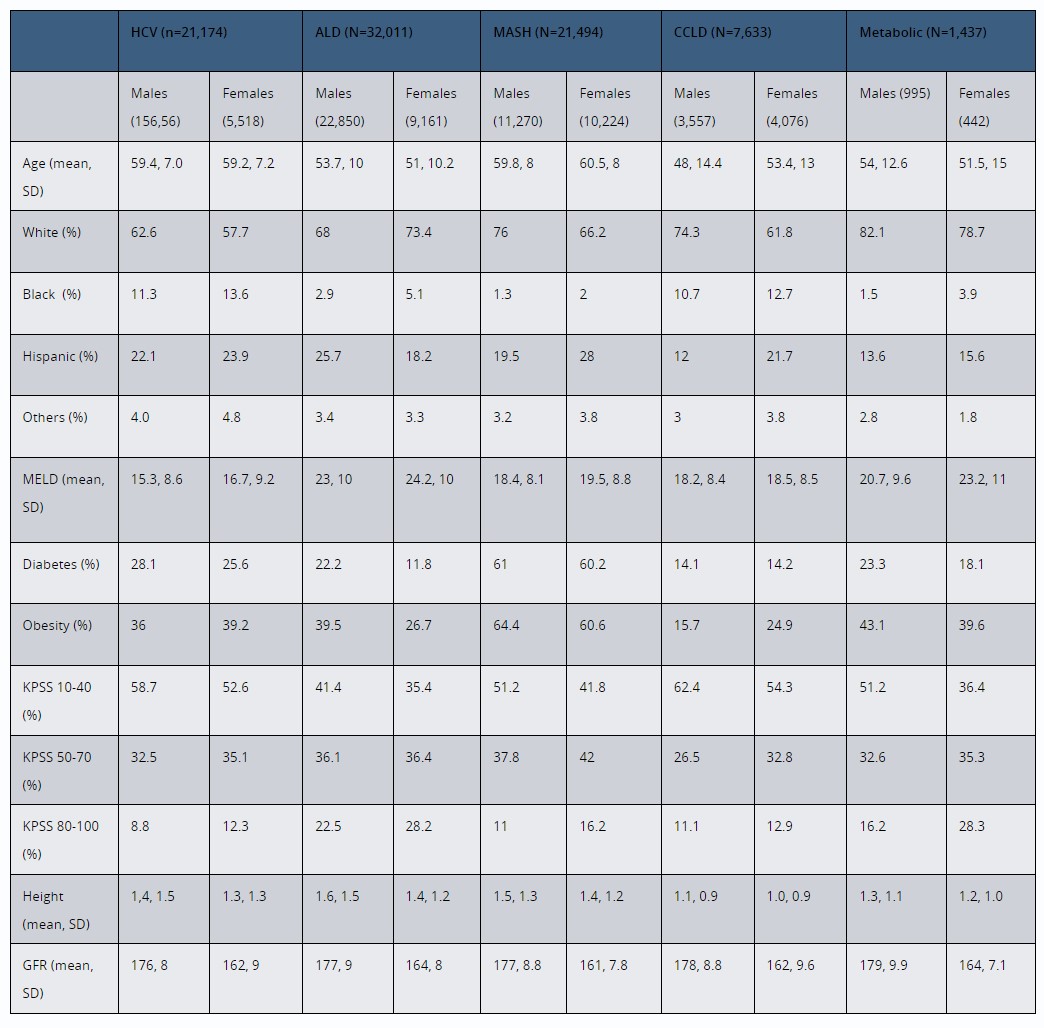Oral Paper Presentation
Annual Scientific Meeting
Session: Plenary Session 2A - Small Intestine / Functional / Liver
26 - Impact of Sex on Liver Transplant Waitlist and Post-Transplant Outcome by Disease Etiology
Tuesday, October 29, 2024
9:40 AM - 9:50 AM ET
Location: Terrace Ballroom 1

Chencheng Xie, MD (he/him/his)
University of South Dakota
Sioux Falls, SD
Presenting Author(s)
Award: ACG/Radhika Srinivasan Gender-Based Research Award
Chencheng Xie, MD1, Sajid Jalil, MD2, Mohamed A. Elfeki, MD1, Mohanad Awadalla, MD3, Abdellatif Ismail, MD4, Prabha Bhandari, MD5, Shaikhoon Mohammed, MD6, Robert Wong, MD, MS, FACG7, Zobair Younossi, MD, MPH, FACG8, Winston Dunn, MD9, Ashwani Singal, MD, MS, FACG5
1University of South Dakota, Sioux Falls, SD; 2Stanford University School of Medicine, San Jose, CA; 3Beth Israel Deaconess Medical Center, Boston, MA; 4University of Maryland Medical Center, Baltimore, MD; 5University of Louisville School of Medicine, Louisville, KY; 6Macon Medical Group PC, Atlanta, GA; 7Stanford/VA Palo Alto, Palo Alto, CA; 8The Global NASH Council, Washington, DC; 9University of Kansas Medical Center, Kansas City, KS
Introduction: A higher waitlist mortality (WLM) due to death or removal for being too sick for liver transplantation (LT) observed among females led to the acceptance of Model for End-stage Liver Disease (MELD) 3.0 in July 2023 for liver allocation. However, there remains a knowledge gap on the role of liver disease etiology on sex sex-based waitlist outcomes. This study aims to examine how sex influences waitlist outcomes across liver disease etiologies.
Methods: We analyzed the United Network for Organ Sharing (UNOS) database (2014-2022) on 88,601 (31,449 females) first LT listings in adults, including 32,011 for alcoholic-associated liver disease (ALD), 21,494 metabolic-associated steatohepatitis (MASH), 21,174 hepatitis C virus (HCV), 2,143 hepatitis B virus (HBV), 7,633 chronic cholestatic liver disease (CCLD), 1,437 metabolic liver disease, and 2,855 fulminant hepatic failure (FHF). Cumulative WLM was analyzed by competing for receiving LT. The Fine-Gray multivariable regression model examined variables associated with waitlist outcome, and results reported as sub-hazard ratio (SHR) with 95% confidence interval (CI).
Results: Females were younger (mean age 55.6 vs. 56.1 yrs.), shorter (mean height 162.2 vs. 176.5 cm), and had lower mean glomerular filtration rate (GFR) (66.4 vs. 76.3 mL/min), higher mean MELD score (20.9 vs. 19.5), more likely to be of black race (7.4% vs. 5.8%) and Karnofsky Performance Status Score (KPSS) >40% (57.7% vs. 50%), p< 0.001 for all. The etiology-based baseline characteristics are shown in the Table. Cumulative WLM in ALD was 14.8% and 16% among females and males, respectively, with 8% lower SHR (95% CI) in females, 0.92 (0.86-0.99), p=0.02. WLM was higher in females for MASH (20.7% vs. 19.4%) and CCLD (15.1% vs. 12.4%), with 8% and 24% higher SHR, respectively. Other variables associated with higher WLM were advanced age, diabetes, lower GFR, lower KPSS, and high MELD scores. Hispanic race was associated with a lower WLM.
Discussion: Waitlist mortality in females is lower for ALD and higher for MASH and CCLD. Since ALD is the most common liver disease etiology, confirming these data in large prospective and ongoing database studies will be relevant to considering liver disease etiology (ALD vs. non-ALD) in allocating donor livers.

Disclosures:
Chencheng Xie, MD1, Sajid Jalil, MD2, Mohamed A. Elfeki, MD1, Mohanad Awadalla, MD3, Abdellatif Ismail, MD4, Prabha Bhandari, MD5, Shaikhoon Mohammed, MD6, Robert Wong, MD, MS, FACG7, Zobair Younossi, MD, MPH, FACG8, Winston Dunn, MD9, Ashwani Singal, MD, MS, FACG5, 26, Impact of Sex on Liver Transplant Waitlist and Post-Transplant Outcome by Disease Etiology, ACG 2024 Annual Scientific Meeting Abstracts. Philadelphia, PA: American College of Gastroenterology.
Chencheng Xie, MD1, Sajid Jalil, MD2, Mohamed A. Elfeki, MD1, Mohanad Awadalla, MD3, Abdellatif Ismail, MD4, Prabha Bhandari, MD5, Shaikhoon Mohammed, MD6, Robert Wong, MD, MS, FACG7, Zobair Younossi, MD, MPH, FACG8, Winston Dunn, MD9, Ashwani Singal, MD, MS, FACG5
1University of South Dakota, Sioux Falls, SD; 2Stanford University School of Medicine, San Jose, CA; 3Beth Israel Deaconess Medical Center, Boston, MA; 4University of Maryland Medical Center, Baltimore, MD; 5University of Louisville School of Medicine, Louisville, KY; 6Macon Medical Group PC, Atlanta, GA; 7Stanford/VA Palo Alto, Palo Alto, CA; 8The Global NASH Council, Washington, DC; 9University of Kansas Medical Center, Kansas City, KS
Introduction: A higher waitlist mortality (WLM) due to death or removal for being too sick for liver transplantation (LT) observed among females led to the acceptance of Model for End-stage Liver Disease (MELD) 3.0 in July 2023 for liver allocation. However, there remains a knowledge gap on the role of liver disease etiology on sex sex-based waitlist outcomes. This study aims to examine how sex influences waitlist outcomes across liver disease etiologies.
Methods: We analyzed the United Network for Organ Sharing (UNOS) database (2014-2022) on 88,601 (31,449 females) first LT listings in adults, including 32,011 for alcoholic-associated liver disease (ALD), 21,494 metabolic-associated steatohepatitis (MASH), 21,174 hepatitis C virus (HCV), 2,143 hepatitis B virus (HBV), 7,633 chronic cholestatic liver disease (CCLD), 1,437 metabolic liver disease, and 2,855 fulminant hepatic failure (FHF). Cumulative WLM was analyzed by competing for receiving LT. The Fine-Gray multivariable regression model examined variables associated with waitlist outcome, and results reported as sub-hazard ratio (SHR) with 95% confidence interval (CI).
Results: Females were younger (mean age 55.6 vs. 56.1 yrs.), shorter (mean height 162.2 vs. 176.5 cm), and had lower mean glomerular filtration rate (GFR) (66.4 vs. 76.3 mL/min), higher mean MELD score (20.9 vs. 19.5), more likely to be of black race (7.4% vs. 5.8%) and Karnofsky Performance Status Score (KPSS) >40% (57.7% vs. 50%), p< 0.001 for all. The etiology-based baseline characteristics are shown in the Table. Cumulative WLM in ALD was 14.8% and 16% among females and males, respectively, with 8% lower SHR (95% CI) in females, 0.92 (0.86-0.99), p=0.02. WLM was higher in females for MASH (20.7% vs. 19.4%) and CCLD (15.1% vs. 12.4%), with 8% and 24% higher SHR, respectively. Other variables associated with higher WLM were advanced age, diabetes, lower GFR, lower KPSS, and high MELD scores. Hispanic race was associated with a lower WLM.
Discussion: Waitlist mortality in females is lower for ALD and higher for MASH and CCLD. Since ALD is the most common liver disease etiology, confirming these data in large prospective and ongoing database studies will be relevant to considering liver disease etiology (ALD vs. non-ALD) in allocating donor livers.

Table: Baseline characteristics at listing based on liver disease etiology. ALD: alcoholic-associated liver disease; MASH: metabolic-associated steatohepatitis; HCV: hepatitis C virus; HBV: hepatitis B virus; CCLD: chronic cholestatic liver disease.
Disclosures:
Chencheng Xie indicated no relevant financial relationships.
Sajid Jalil indicated no relevant financial relationships.
Mohamed Elfeki indicated no relevant financial relationships.
Mohanad Awadalla indicated no relevant financial relationships.
Abdellatif Ismail indicated no relevant financial relationships.
Prabha Bhandari indicated no relevant financial relationships.
Shaikhoon Mohammed indicated no relevant financial relationships.
Robert Wong: Durect Corporation – Grant/Research Support. Exact Sciences – Grant/Research Support. Gilead Sciences – Grant/Research Support. Thera Technologies – Grant/Research Support.
Zobair Younossi: Intercept, Cymabay, Boehringer Ingelheim, Ipsen, BMS, GSK, NovoNordisk, Merck and Abbott. – Grant/Research Support. Madrigal – Grant/Research Support. Siemens – Grant/Research Support.
Winston Dunn indicated no relevant financial relationships.
Ashwani Singal: AASLD – Advisory Committee/Board Member. AGA Council – Advisory Committee/Board Member. CLD Foundation – Advisor or Review Panel Member, Independent Contractor. GSK – Grant/Research Support. Madrigal – Speakers Bureau. Medical Speaker's Network – Speakers Bureau. Medscape – Speakers Bureau. NIAAA – Grant/Research Support. Pleiogenix – Consultant, Stock Options. University of Louisville School of Medicine – Employee. Up-to-Date – Royalties.
Chencheng Xie, MD1, Sajid Jalil, MD2, Mohamed A. Elfeki, MD1, Mohanad Awadalla, MD3, Abdellatif Ismail, MD4, Prabha Bhandari, MD5, Shaikhoon Mohammed, MD6, Robert Wong, MD, MS, FACG7, Zobair Younossi, MD, MPH, FACG8, Winston Dunn, MD9, Ashwani Singal, MD, MS, FACG5, 26, Impact of Sex on Liver Transplant Waitlist and Post-Transplant Outcome by Disease Etiology, ACG 2024 Annual Scientific Meeting Abstracts. Philadelphia, PA: American College of Gastroenterology.


